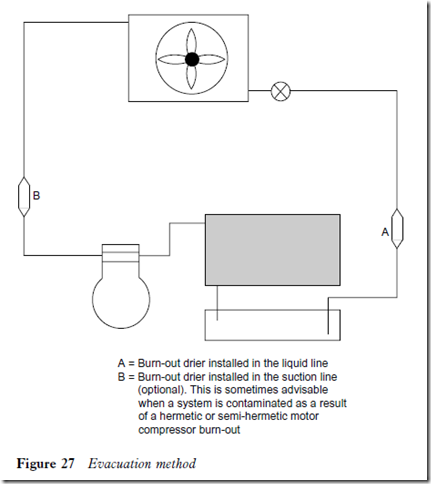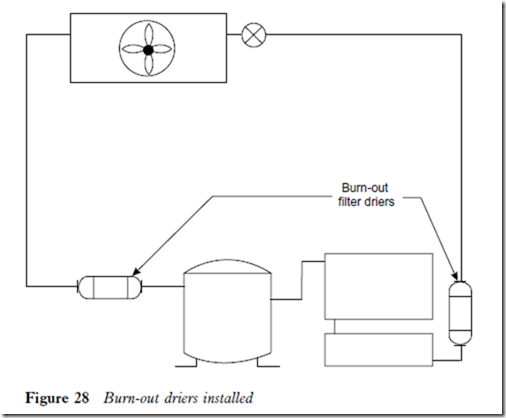Compressor motor burn-out: system flushing
Prolonged operation at high discharge pressures and temperatures, excessive motor starting, fluctuating voltage conditions, shortage of refrigerant charge and shortage of oil in the compressor are all possible causes of a motor burn-out.
A burn-out can be defined as the motor winding insulation having been exposed to a critical temperature for a long period.
Refrigerant thermal decomposition
This occurs with R12, R22 and R502 at temperatures in excess of 150 °C (302 °F). In the presence of hydrogen-containing molecules, thermal decomposition produces hydrochloric and hydrofluoric acids. Phosgene is produced at very high temperatures, but this is decomposed in the presence of oxygen.
Bearing in mind the above, it is important to remove the entire refrigerant charge and reclaim the refrigerant for processing. A recognized reclaim refrigerant cylinder should be used and care taken not to overfill the cylinder.
Acid testing
When the windings insulation breaks down, very high temperatures occur at the short circuited location. In addition, a certain amount of moisture will be released from the windings assembly to further contaminate the system. Following a motor burn-out, the system must be decontaminated before a new compressor is fitted.
When the defective motor has been removed, a test should be made to determine the acid content of the compressor oil. Two methods may be used: litmus paper and burn-out test indicator. A sample of the oil from the defective motor compressor should be taken and tested. If the test indicates acid, then the refrigerant system must be flushed and tested as follows. Flushing is dealt with overleaf.
Litmus paper
Take a sample of the solvent after flushing and put it into a suitable container. Place the litmus paper in the liquid. If acid is present it will change colour, ranging from pink to red according to the degree of acidity in the sample. The system must then be flushed again and the test repeated.
Indicator
When testing with an indicator it is necessary to charge the system with the liquid solvent ready for flushing and allow to stand for 30 minutes. Then take samples of the solvent, if possible from both the high and the low side of the system.
Add the prescribed amount of indicator to the samples and agitate the mixture; examine for a colour change. The results and necessary actions are as follows:
1 If red or pink, strong acid content: flush again.
2 If orange or yellow, acid content: flush again.
3 If carbonized particles are present in the samples: flush again.
4 If lemon yellow, no acid content: system may be evacuated.
System flushing
When a system has been contaminated, especially following a hermetic motor compressor ‘burn out’, the past practice was to flush the system through with R11. This practice is no longer acceptable.
Approved burn-out filter driers are available these days to make flushing unnecessary. Instead the system can be cleansed by installing suitable filter driers and carrying out a triple evacuation (see Chapter 16, Dilution method). The filter driers will absorb moisture and acid content from the system pipework.
Evacuation
During the evacuation of the system, evaporator fans and electric defrost heaters may be switched on to raise the temperature of the evaporator. However, extreme care must be taken to avoid overheating by the defrost heaters.
Burn-out drier
After a system has been repaired and evacuated, burn-out driers installed, leak tested and charged with refrigerant it should be operated for a period of 24 hours. An acid test should then be carried out and, if satisfactory, the burn-out driers can be removed and exchanged for normal filter driers. When an acid test reveals contamination new, burn-out driers must be installed and the process repeated.
Burn-out filter driers

